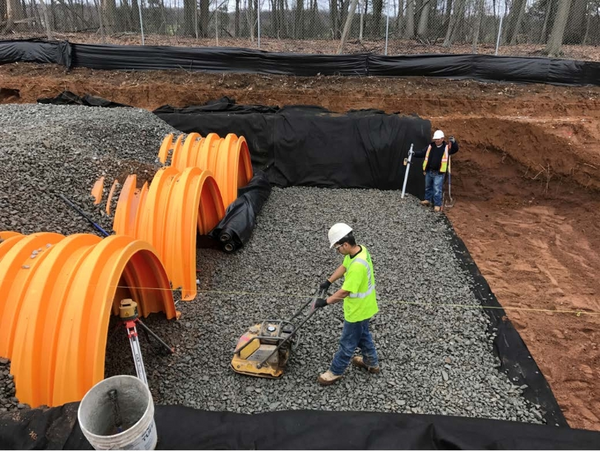
Stuart Crisp, UK manager of Advanced Drainage Systems (ADS) looks at how the porosity of structural backfill around arch-shaped attenuation chambers relates to storage volume, design and calculation.
In subsurface stormwater management systems, selecting the right embedment material is critical to balancing structural integrity with hydraulic capacity. For example, arch-shaped chambers, such as ADS StormTech, recommend that clean, single-sized, angular aggregate conforming to BS EN 13242 grade 20/40 is used in the zones surrounding its chambers and has a porosity value of 40%.This makes the attenuation system more efficient as it enables additional storm water to be stored within the voids of the stone.
This value is based on empirical data and installation practices, and it is essential for accurate storage volume calculations and long-term system performance.
Definition of porosity
Porosity (n) is defined as the percentage of void (empty) space within a material relative to its total volume. It is calculated using the formula: n = (Vv / Vt) × 100%, where Vv is the volume of voids and Vt is the total volume.
Related but distinct is the void ratio (e), expressed as a decimal: e = Vv / Vs, where Vs is the volume of solids. While often used in geotechnical engineering, void ratio should not be confused with porosity in hydraulic design applications. An embedment with a void ratio of 40% would not provide the required 40% porosity.
Why 40%?
Clean, single-sized, angular stone aggregate for foundation and embedment material inherently exhibits high porosity due to the absence of fine particles that would otherwise fill the voids between larger stones. StormTech arch-shaped attenuation chamber installation guidelines differentiate porosity between compacted and non-compacted conditions.
The foundation layer is compacted to ensure structural stability beneath the arch-shaped chamber. Aggregate placed in the embedment zone, which surrounds the sides and top of the chambers, is typically dumped and left uncompacted to avoid damaging the chambers. This looser placement yields average porosities above 45%.
While compaction can reduce porosity slightly, the difference is mitigated by the installation method. In practice, compacted bedding material still maintains an average porosity of approximately 40% based on laboratory and field test data. Since the embedment stone is not compacted, it generally has a greater porosity, and when averaged across both zones, the overall system porosity exceeds 40% making it a conservative and reliable value for design purposes.
Protection against soil migration
To maintain porosity and prevent soil fines from infiltrating and clogging the void space, arch-shaped attenuation chamber infiltration systems are encapsulated in a non-woven geotextile fabric. This geotextile acts as a barrier to soil migration while allowing water to pass through.
Using a 40% porosity for structural aggregate in arch-shaped chamber systems, such as StormTech, is both conservative and well-supported by rigorous testing. Designers can confidently apply this value in storage volume calculations, ensuring structural integrity and storage efficiency.
Further details can be found in ADS’s Technical Note 6.30, available at https://adspipe.co.uk/resources/